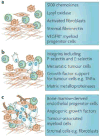The metastatic niche: adapting the foreign soil - PubMed (original) (raw)
Review
The metastatic niche: adapting the foreign soil
Bethan Psaila et al. Nat Rev Cancer. 2009 Apr.
Abstract
The 'seed and soil' hypothesis for metastasis sets forth the concept that a conducive microenvironment, or niche, is required for disseminating tumour cells to engraft distant sites. This Opinion presents emerging data that support this concept and outlines the potential mechanism and temporal sequence by which changes occur in tissues distant from the primary tumour. To enable improvements in the prognosis of advanced malignancy, early interventions that target both the disseminating seed and the metastatic soil are likely to be required.
Figures
Figure 1. A model of the evolution of a metastatic niche
This figure depicts the premetastatic, micrometastatic to macrometastatic transition. (A) In response to growth factors secreted by the primary tumour including vascular endothelial growth factor (VEGF), placental growth factor (PlGF) and transforming growth factor-b (TGF- b), inflammatory S100 chemokines and serum amyloid A (SAA) 3, are upregulated in premetastatic sites leading to clustering of bone marrow-derived haematopoietic progenitor cells (HPCs). Platelet-deployed stromal-derived growth factor (SDF)-1 is also chemotactic for CXCR4+ HPCs and metastatic tumour cells (MTCs). HPCs secrete a variety of premetastatic factors including TNF-a, matrix metalloproteinase (MMP)-9 and TGF-β, , Activated fibroblasts secrete fibronectin, an important adhesion protein in the niche, and lysoyl oxidase (LOX) expression is increased, modifying the local extracellular matrix. (B) MTCs engraft the niche to populate micrometastases. The site specific expression of adhesion integrins on activated endothelial cells such as P-selectin and E-selectin may enhance MTC adhesion and extravasation at these sites, and cell-cell interactions such as CD44 ligation in the metastatic niche may promote MTC survival and enable proliferation. (C) Recruitment of endothelial progenitor cells (EPCs) to the early metastatic niche mediates the angiogenic switch and enables progression to macrometastases, .
Figure 2. Stage-specific targeting of the metastatic microenvironment
Cellular and molecular targets relevant to each stage of metastatic development are suggested as ammunition for future anti-metastatic therapies.
Similar articles
- Osteotropic cancers: from primary tumor to bone.
Buijs JT, van der Pluijm G. Buijs JT, et al. Cancer Lett. 2009 Jan 18;273(2):177-93. doi: 10.1016/j.canlet.2008.05.044. Epub 2008 Jul 15. Cancer Lett. 2009. PMID: 18632203 Review. - Priming the 'soil' for breast cancer metastasis: the pre-metastatic niche.
Psaila B, Kaplan RN, Port ER, Lyden D. Psaila B, et al. Breast Dis. 2006-2007;26:65-74. doi: 10.3233/bd-2007-26106. Breast Dis. 2006. PMID: 17473366 Review. - Preparing the "soil": the premetastatic niche.
Kaplan RN, Rafii S, Lyden D. Kaplan RN, et al. Cancer Res. 2006 Dec 1;66(23):11089-93. doi: 10.1158/0008-5472.CAN-06-2407. Cancer Res. 2006. PMID: 17145848 Free PMC article. Review. - Pre-metastatic niches: organ-specific homes for metastases.
Peinado H, Zhang H, Matei IR, Costa-Silva B, Hoshino A, Rodrigues G, Psaila B, Kaplan RN, Bromberg JF, Kang Y, Bissell MJ, Cox TR, Giaccia AJ, Erler JT, Hiratsuka S, Ghajar CM, Lyden D. Peinado H, et al. Nat Rev Cancer. 2017 May;17(5):302-317. doi: 10.1038/nrc.2017.6. Epub 2017 Mar 17. Nat Rev Cancer. 2017. PMID: 28303905 Review. - Characteristics and Significance of the Pre-metastatic Niche.
Liu Y, Cao X. Liu Y, et al. Cancer Cell. 2016 Nov 14;30(5):668-681. doi: 10.1016/j.ccell.2016.09.011. Cancer Cell. 2016. PMID: 27846389 Review.
Cited by
- Lung bronchiectasisas a paradigm of the interplay between infection and colonization on plastic modulation of the pre-metastatic niche.
Pisanu L, Mucaj K, Conio V, Bertuccio F, Giana I, Arlando L, Russo M, Montini S, Bortolotto C, Corsico AG, Stella GM. Pisanu L, et al. Front Oncol. 2024 Oct 14;14:1480777. doi: 10.3389/fonc.2024.1480777. eCollection 2024. Front Oncol. 2024. PMID: 39469649 Free PMC article. - Effect of colony‑stimulating factor in the mechanism of bone metastasis development (Review).
Han Y, Wang Y, Lv T, Yang Q, Cheng D, Li J, Wang W, Huang J, Peng X. Han Y, et al. Oncol Rep. 2024 Dec;52(6):165. doi: 10.3892/or.2024.8824. Epub 2024 Oct 18. Oncol Rep. 2024. PMID: 39422059 Free PMC article. Review. - Lipids in the tumor microenvironment: immune modulation and metastasis.
Pascual G, Benitah SA. Pascual G, et al. Front Oncol. 2024 Sep 26;14:1435480. doi: 10.3389/fonc.2024.1435480. eCollection 2024. Front Oncol. 2024. PMID: 39391242 Free PMC article. Review. - DEAD-box RNA helicases in the multistep process of tumor metastasis.
Li S, Feng T, Yuan H, Li Q, Zhao G, Li K. Li S, et al. Mol Biol Rep. 2024 Sep 22;51(1):1006. doi: 10.1007/s11033-024-09912-9. Mol Biol Rep. 2024. PMID: 39306810 Review. - Enhancing outcome prediction of concurrent chemoradiation treatment in patients with locally advanced cervical cancer through plasma extracellular vesicle proteomics.
Leetanaporn K, Chiangjong W, Roytrakul S, Molika P, Janmunee N, Atjimakul T, Hanprasertpong J, Navakanitworakul R. Leetanaporn K, et al. Heliyon. 2024 Aug 22;10(16):e36374. doi: 10.1016/j.heliyon.2024.e36374. eCollection 2024 Aug 30. Heliyon. 2024. PMID: 39262965 Free PMC article.
References
- Paget S. The distribution of secondary growths in cancer of the breast. Lancet. 1889;1:571–573. - PubMed
- Paget S. The distribution of secondary growths in cancer of the breast. 1889. Cancer Metastasis Rev. 1989;8:98–101. - PubMed
- Virchow R. In: Cellularpathologie. 4th. Hirschwalkd A, editor. Berlin: 1858.
- Ewing J. In: Neoplastic diseases. 6th. Saunders W, editor. Philadelphia, PA: 1928.
- Fidler IJ, Kripke ML. Metastasis results from preexisting variant cells within a malignant tumor. Science. 1977;197:893–5. - PubMed
Publication types
MeSH terms
LinkOut - more resources
Full Text Sources
Other Literature Sources

